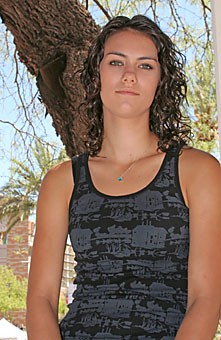Learning to tie your shoes is an important lesson for all kids, but it can be a difficult one for children with autism.
Margo Johnson, a senior at Tucson Magnet High School, worked with UA faculty to develop an interactive computer program to teach children with autism skills such as tying shoes, after observing the difficulties her 12-year-old sister, Katy, who was diagnosed with autism, had in learning simple life skills.
Autism is one of a group of developmental disabilities called autism spectrum disorders, or ASDs. ASDs vary in severity and specific symptoms, but generally cause impairment in communication, learning and social skills, according to the Center for Disease Control and Prevention Web site.
Data released this year by the CDC’s Autism and Developmental Disabilities Monitoring Network indicates that one out of every 150 8-year-old children in the U.S. has an ASD.
“”I wanted to teach her some basic life skills, and I found research that states you could teach cognitive life skills with video programming on the computer,”” Johnson said. “”So I started making programs working with my sister to figure out the steps.””
Working over the summer with UA faculty advisers and specialists in various forms of computer graphics development and programs at the Learning and Technologies Center, Johnson has developed two programs.
The first, titled “”Let’s Learn To Tie Our Shoes,”” uses repetition to teach the basic steps of tying one’s shoes. The second video, “”Craig’s House,”” focuses on different tasks that are performed in the bedroom, such as buttoning a shirt or making a bed, Johnson said.
The process of making the videos was complex.
Johnson worked with specialists at the LTC to learn the various computer programs and skills needed to create an interactive computer program, said M. Theresa Tostes-Ribeiro McLaughlin, an instructional technology specialist at the LTC.
“”I put her in contact with the people here who did these things and got her to be trained in different applications that she needed to be trained in,”” McLaughlin said.
The actual video was shot in the KUAT studios and then Johnson used technology at the LTC to make it interactive, McLaughlin said.
Johnson is now studying how effective “”Craig’s House”” is in teaching autistic children through research. The research study has families use the program for three 20-minute sessions over three weeks, with assessments at the beginning and end of the study to measure progress, Johnson said.
Currently, nine families have finished the study, while 16 are participating in the study and a couple of families are contemplating undertaking the study, Johnson said.
Although Johnson cannot yet draw definite conclusions, “”there definitely is an overall increase in skill acquisition,”” she said.
In the future, Johnson hopes to use the data gathered in the story to make changes in the video. If the DVD proves successful, she may market “”Craig’s House”” in stores.
“”It would be a really great option, if it works,”” Johnson said.
If marketed, the DVD would provide families of autistic children with a cheaper alternative than therapy, which tends to be expensive.









